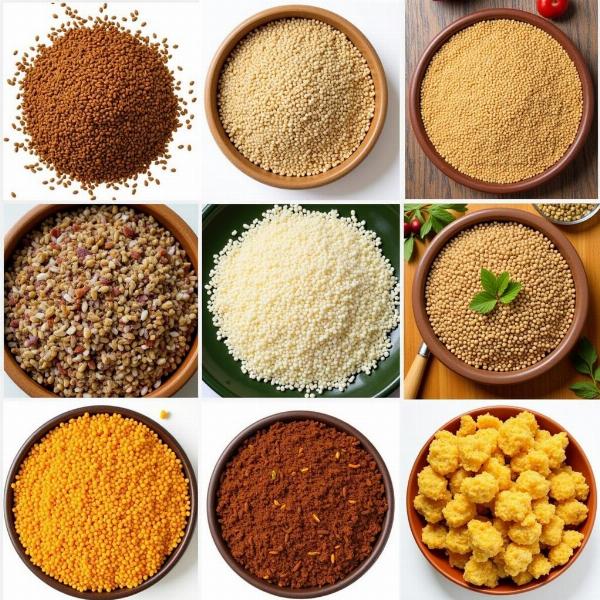Knowing the names of grains in both English and Hindi is essential for anyone navigating the diverse culinary landscape of India. Whether you’re a seasoned cook, a curious foodie, or simply looking to expand your vocabulary, this guide will provide a comprehensive list of grains, their names in both languages, and some interesting facts about their usage and cultural significance.
Common Grains in Indian Cuisine
India is a land of diverse agricultural practices, and grains form the cornerstone of its culinary traditions. From the staple rice and wheat to lesser-known millets and pseudocereals, the variety is truly astounding. Let’s delve into some of the most commonly used grains in Indian kitchens:
-
Rice (Chawal – चावल): Perhaps the most widely consumed grain in India, rice comes in countless varieties, each with its unique texture and flavor. From the fragrant Basmati to the sticky Gobindobhog, rice is a staple in every region.
-
Wheat (Gehun – गेहूँ): Another essential grain, wheat is primarily used to make roti, chapati, and a variety of other flatbreads. It’s also ground into flour (atta – आटा) for making puris, parathas, and numerous other delicacies.
-
Corn (Makka – मक्का): While not as ubiquitous as rice and wheat, corn plays a significant role in Indian cuisine, especially in the northern regions. It’s used in various dishes, from simple roasted corn on the cob to more complex preparations like makki ki roti.
-
Barley (Jau – जौ): Known for its nutritional value, barley is often used in soups, stews, and porridges. It’s also used to make sattu, a roasted flour that’s popular in Bihar and Jharkhand.
-
Oats (Jai – जई): Gaining popularity for its health benefits, oats are increasingly consumed as breakfast cereal or used in baked goods.
Exploring Millets: The Ancient Grains
Millets, often referred to as ancient grains, are making a comeback in modern diets due to their nutritional value and resilience in harsh climates. Here are some prominent millets and their Hindi names:
- Pearl Millet (Bajra – बाजरा): A staple in Rajasthan and other arid regions, bajra is rich in fiber and minerals. It’s used to make roti, khichdi, and other traditional dishes.
 Millets like Bajra and others in India
Millets like Bajra and others in India
-
Sorghum (Jowar – ज्वार): Another important millet, jowar is used to make roti, bhakri, and other flatbreads. It’s also used in porridges and other preparations.
-
Finger Millet (Ragi – रागी): Highly nutritious, ragi is especially beneficial for infants and growing children. It’s commonly used to make porridge, dosa, and other dishes.
Pseudocereals: Seeds that Act Like Grains
While not technically grains, pseudocereals are seeds that are used in similar ways and offer comparable nutritional profiles. Here are a few examples:
-
Buckwheat (Kuttu – कुट्टू): Often consumed during fasting periods, kuttu is used to make flour for rotis, pancakes, and other dishes.
-
Quinoa (Kinwa – क्विन्वा): A complete protein source, quinoa is gaining popularity in India for its nutritional value and versatility.
What is the Hindi Word for Grains?
The Hindi word for grains collectively is “Anaaj” (अनाज). This term encompasses all types of grains, including cereals, millets, and pseudocereals.
Grains Name in English and Hindi Chart
For quick reference, here’s a table summarizing the names of various grains in English and Hindi:
| English Name | Hindi Name |
|---|---|
| Rice | Chawal (चावल) |
| Wheat | Gehun (गेहूँ) |
| Corn | Makka (मक्का) |
| Barley | Jau (जौ) |
| Oats | Jai (जई) |
| Pearl Millet | Bajra (बाजरा) |
| Sorghum | Jowar (ज्वार) |
| Finger Millet | Ragi (रागी) |
| Buckwheat | Kuttu (कुट्टू) |
| Quinoa | Kinwa (क्विन्वा) |
Conclusion
Understanding the names of grains in both English and Hindi opens a window into the rich culinary heritage of India. From the everyday staples to the lesser-known millets and pseudocereals, each grain has a unique place in Indian cuisine. This comprehensive guide provides a valuable resource for anyone seeking to learn more about these essential ingredients. So, the next time you’re exploring the vibrant world of Indian food, you’ll be well-equipped to identify and appreciate the diverse grains that make it so special.
FAQ
-
What are the most common grains used in India? Rice and wheat are the most commonly consumed grains in India.
-
What is the Hindi word for millet? Millets are collectively known as “mota anaaj” (मोटा अनाज) in Hindi. However, individual millets have their specific names.
-
What are pseudocereals? Pseudocereals are seeds that are cooked and eaten like grains, but they don’t belong to the same botanical family as true cereals.
-
Why are millets gaining popularity? Millets are gaining popularity due to their nutritional value, gluten-free nature, and suitability for diverse climates.
-
Where can I find more information about Indian grains? You can find more information about Indian grains on websites dedicated to Indian cuisine, agricultural resources, and nutritional databases.
Meaning-Hindi.in offers professional translation services specializing in Hindi and various other languages. Our expertise spans business, legal, technical, website localization, and academic document translation. Whether you need quick translation or specialized industry expertise, Meaning-Hindi.in is your trusted partner. Contact us at [email protected] or +91 11-4502-7584.